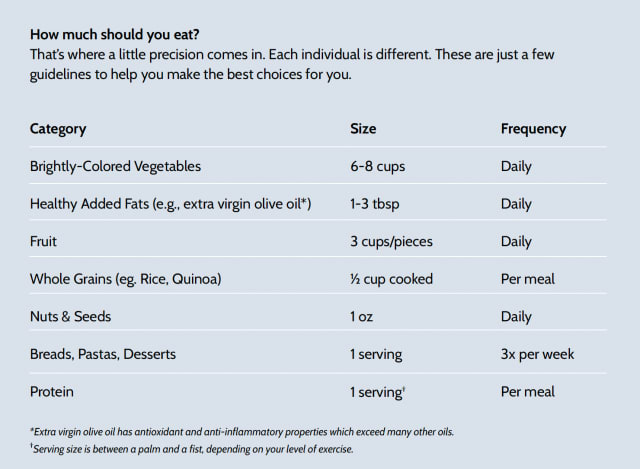As the New Year begins, many people look at their lifestyle habits and think about ways to feel healthier in the coming months.
Two key pieces of eating well are 1) the best foods and 2) the optimal amount of food. #1 has some variation among individuals, but research has consistently shown that a variety of brightly-colored vegetables supplies the body with the cancer-fighting, immune-boosting nutrients everyone needs. Whole grains, high-quality, plant-based proteins, and healthy fats such as olive oil round out a healthy eating plan.
But how much of each type of food?
Government and doctor recommendations for portion sizes have not increased over time, but anyone who has eaten out at a restaurant knows that the amount of food you are served is often more than you can eat. Opportunities to pay a fraction more money to “supersize” your soda or get a bowl of pasta the size of your head are everywhere.
When you eat excess food, it triggers your body to convert calories to fat. Portion sizes are where the rubber meets the road: it is important to eat appropriate amounts of various healthy foods at each sitting.
There’s more variation among people in how much food they need each day. It depends on several factors such as body size and composition, age, any medical conditions, and activity level. If you’re training for a 5K run or you lift weights 3x/week, you may need more food. If you’re trying to lower your BMI, or you just turned 60, you may need less food than you did in the past. If you’re starting—or just finishing—cancer treatment, talk to your doctor about any special dietary considerations.
And then there’s the pandemic. For many people, activity levels took a nosedive. In one large international survey, 66% of people reported that they were unable to maintain their usual level of activity. Older people reported greater declines in activity. Not only did we stop going to the gym, but as we stayed more at home, we got less “incidental” daily physical activity, like walking over to the printer at the office or to the neighborhood coffee shop to meet a friend. As your circumstances change, so will the amount of food you need.
A Note on Vegetables
At first glance, 6-8 cups may seem like a lot of vegetables – likely more than you’re used to eating. But remember that raw vegetables take up a lot of room. A big veggie salad for lunch could contain 4 cups of vegetables. A bowl of homemade veggie stew at dinner probably started out as two cups of raw vegetables.
If you’re new to a plant-centric diet, try the 1-2-3 principle (including a veggie at breakfast, two at lunch, and three at dinner), and increase your intake over a couple of weeks.
Why are Pasta and Bread with Dessert?
Most pastas and breads are made of refined grains. Highly refined grains (such as white flour) behave similarly to sugar in your body. Read your labels, choose carefully, and balance your daily choices (e.g., if you have a sandwich at lunch, skip the whole grains at that meal). If this feels like a big change to you all at once, take it a little bit at a time every week.
For more tips on nutrition, exercise, and rest, download The Science of Living Well, Beyond Cancer.










